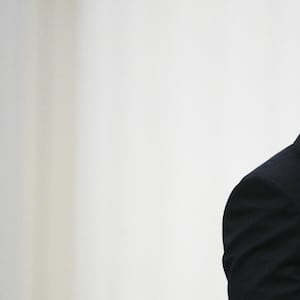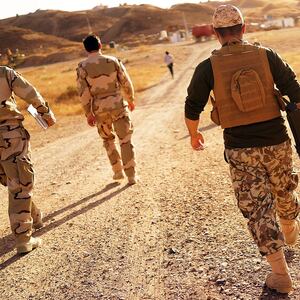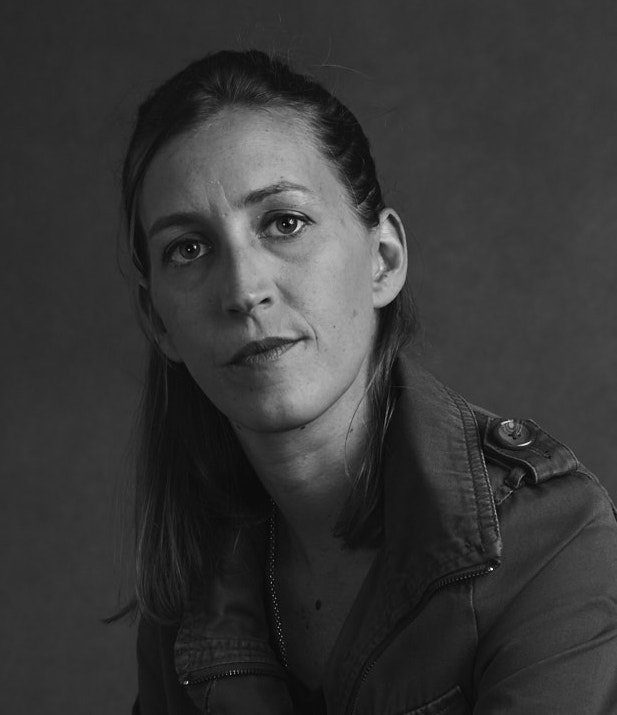HASAKAH, Syria—The sun was setting when the car turned right toward the town of Serekanye last Saturday, leaving behind a fairly busy road and the last checkpoint before the war zone. The hour-long drive had been a race against time. “We need to get there before dark, it is way too dangerous at night,” said Tolheidan, a twentysomething Kurd dressed in loose pants and a green jacket. He is one of the fighters who came to pick us up to bring us to the front line. Normally, no journalists are allowed.
“Drones and planes are all over this area, we need to be careful, sometimes they strike anything that moves,” he said, driving at a very high speed while listening to loud Kurdish rap songs. The road was empty, just a few motorbikes were traveling at regular speed. Each village we passed seemed empty, though in a few cases grey-haired men were sitting outside smoking and chatting.
At 4:30 p.m. the car entered a small village with no more than 20 mud houses. The last rays of the sun colored everything in a warm orange light, creating a magical atmosphere. We stopped under a tree in a yard where dozens of hens and two turkeys were strolling around picking bread crumbs from the ground. Their small noises made us aware of the wider silence, which seemed almost unreal.
ADVERTISEMENT
A little mosque next door was not playing the Azan, the call to evening prayer. Doves began singing as night was falling. Then the quiet was interrupted by a couple of distant shots. And then a female voice: “Keramke,” or “come in” in Kurdish. Berivan stood before us, a big smile lighting her face, and for a moment it erased the fatigue in her eyes. “We have been waiting for you, why are you so late?” she joked as she greeted us with a vigorous handshake and a hug.
We went through a white metal door leading to a room with pale carpets and red pillows on the floor. On the walls: pictures of elderly couples, and a traditional Kurdish red flower tapestry. The family who used to live in this house had fled no more than 10 days before. They took everything with them that they could carry, but that was not everything they owned. They knew that this time they might not be able to come back, but they knew as well there was no time to waste.
This area has been safe for the past six years, ever since Kurdish-led forces managed to defeat al Qaeda-affiliated Jabhat Al Nusra and some Free Syrian Army (FSA) cells working with it. Once it was secured, the self-administration of Rojava, the Syrian Kurdish area of Syria, also known as Western Kurdistan, took over.
For years the Kurds worked hard to develop an inclusive democratic project for the whole of this part of Syria. They call it the “third way,” not with the Assad regime nor with the opposition. They built a haven for ethnic and religious minorities, marked by an emphasis on ecology, feminism, and direct democracy. The established a co-chair system, men and women sitting in the position of power throughout the self-administration and military. The system works around communes which organize daily life, economy, education, justice, and health. Now all of this is at stake.
In the past month, everything changed in the region, including alliances. There are daily twists and pivotal changes.
It all started with a phone call that overturned the life of more than 5 million people living in the area, and it almost broke the alliance between the SDF—the Syrian Democratic Forces, an umbrella organization that includes Kurds, Arabs, Syriacs fighters—and the United States in the fight against the so-called Islamic State.
On Oct. 6, U.S. President Donald J. Trump in a conversation with Turkish President Recep Tayyip Erdogan decided to withdraw American special operations forces from northeast Syria. Trump announced the change in a tweet in the middle of the night in Syria, catching everyone off guard including the Pentagon.
For months before that, the Turkish president had made public threats to the region while the U.S. acted as a mediator. Turkey has never accepted the Syrian Kurds creating an autonomous region along its border. If the political project succeeds in northeast Syria, Kurds in Turkey might want to emulate the system and claim more autonomy from the state. Over the summer top U.S. officials worked on a deal between the SDF and Turkey to prevent a conflict in the area.
In 2011, when the Syrian crisis started the Kurds established the YPG—the People’s Protection Units—as a self-defense force. Some of the members were former PKK Syrian fighters. In 2015, the SDF was set up by the International Coalition against ISIS and it changed the balance—the majority of fighters were actually Arabs. In the past four years SDF’s priority has always been fighting ISIS, and there were no attacks north of the borders towards Turkey. According to a report by the Rojava Information Center, an independent research study group, in the first half of 2019 there has been at least 30 cross-border attacks from Turkey to Rojava. Just one in the opposite direction.
In August, the SDF agreed to dismantle its fortifications in a designated area at the border and allowed Turkey to patrol there with U.S. forces. For Ankara that was not enough, and three days after the U.S. moved its forces out of the way, on Oct. 9, Turkey started an invasion, shelling most of the major cities of Rojava. It created chaos, killed civilians, and forced thousands to flee their homes.
Turkey’s “Operation Spring of Peace” concentrated its efforts on two cities: Serekanye (Rais Al Ain) and Gire Spi (Tal Abyad) both on the border and about 110 km (68 miles) apart. Turkey shelled hospitals and nonmilitary targets, committing what are widely alleged to have been war crimes.
Turkish militias known as the TFSA executed “in cold blood” Hevrin Khalef, a 35-year-old politician serving as a secretary general of the Future Syria Party. She was “dragged out of her car, beaten and shot dead,” according to Amnesty International. The coroner’s report added graphic details posted on Twitter by New York Times correspondent Rukmini Callimachi.
One day later, on Oct. 13, Gire Spi fell, but Serekanye resisted. TFSA advanced, supported with air coverage from the second-largest army in NATO.
On Oct. 17, the U.S. and Turkey agreed on a 120-hour ceasefire, during which the SDF retreated from Serekanye, and moved its troops 32 km (19 miles) away from the border. Erdogan calls this region where he will impose Turkish control, a “safe zone” and plans to resettle some 2 million Syrian refugees, most of whom come from other parts of the country.
There followed another agreement on Oct. 22, this time between Turkey and Russia, which aimed to contain Erdogan’s ambitions to expand the area under his control. The 13 points of this memorandum agreed at a summit in Sochi, Russia, made clear that Turkey should stay in the designated area while other parts of the border would be patrolled by Russian military police and the Syrian regime.
Ankara never really respected the Sochi accords and, continuing its offensive despite the truce, and widening the attacks. SDF commander in chief Mazloum Abdi repeatedly exposed the violations of the truce.
The village we were staying in is outside the “safe zone” and the fight has been intense. “It was the strangest ceasefire I have ever seen in my life,” said Berivan, our weary-looking 35-year-old host. She sat on the floor smoking a cigarette as we talked. She has always been a heavy smoker. Originally from the city of Qamishli, Berivan is a leading commander, and has fought in the war against ISIS since the battle of Kobane in 2014. She has long brown hair and speaks good English.
Of the current confrontation with Turkey, she says, “We never really stopped fighting, they continued the shelling. Some days were very heavy and we couldn’t move.” Everything is different in this war, she admitted. There is little ground combat, the SDF is taking many casualties due to the intensive air and artillery campaign. Drones scan the territory, then the heavy weapons target houses. So far at least 1,000 people have died, half of them civilians, says Berivan. According to medical reports over 90 percent of the victims died because of wounds from shell and shrapnel. Turkey also has been accused of using white phosphorus on nonmilitary targets. So far no one has agreed to test the sample. The Times of London and Newsweek recently reported that various NATO countries have asked the U.N. watchdog agency, the Organization for the Prohibition of Chemical Weapons, not to investigate this alleged offense by a NATO ally.
“We just ask for a no-fly zone, we don’t want other armies to fight for us,” said Berivan. The Syrian regime has sent troops, but they are said to be poorly equipped with no real willingness to participate in the fight. When interviewed, one experienced Syrian team leader, Omar Abed Almajid, told The Daily Beast that the situation was chaotic. “They sent us to die,” he said while lying in a bed at the hospital in Tel Tamer on Oct. 29. “Our leaders told us we were not going to fight, we were just going to patrol the border. Instead Turkey massacred us with heavy weapons”
Almajid was injured while trying to open a corridor for civilians to escape. His troops didn’t have any armored cars or heavy weapons to protect themselves.
Most of the soldiers of the Assad regime’s SAA–Syrian Arab Army–expected air coverage to be provided by Moscow, with which they’ve had an active alliance since 2015. They were wrong. So far the Kremlin has stayed out of the fight while patrolling certain areas. The Syrian regime retreated from the front lines several times to try to come back the day after. This has happened almost everywhere and on a daily basis.
Berivan also recalled the story of a regime unit stationed on her side of the front surrendering to the TFSA militias. “They had orders not to fire back because of the ceasefire. We begged them not to give up, they needed to at least defend themselves.” They didn’t listen. Straight after being captured, they all got executed, she said, and a video circulated online.
Berivan’s group, two women and three men, had been caught out of contact with the world for almost 10 days. Communication is strictly over the radio, and brief. They have no internet because they are afraid armed drones can pick up their GPS coordinates if they access it. She didn’t know about Abu Bakr al-Baghdadi’s death. At first, she was in disbelief and then started laughing as we explained the details of the raid
“We have so many Baghdadis that his death doesn’t make a difference,” said Shero, sitting next to her. He chain smoked while checking on the progress of the different factions. The area is flat, and villages are used as FOBs–Forward Operating Bases. As the hours passed the movements around us increased. We could hear some shelling, though after a few hours the night went on as quiet. Both Berivan and Shero stayed up until 5:00 a.m. to check on the situation.
The fight resumed around 9 a.m., and movement was impossible for about two hours. We could hear planes and drones overhead with shelling around us. We wanted to get to Zergan (Abu Rasin), a major town in the area. “Now it is not safe,” said Berivan. We waited under a tree, drinking tea, for a couple of hours. Then we started out.
Less than a mile north, a small settlement was completely abandoned. The few houses were around a deserted church. There were a lot of Christians in the area. Now they’ve all left. They knew if the TFSA arrived their lives could be in danger.
The SDF forces in the area are highly suspicious of the people who stayed. This is an active war zone. “When civilians leave is not good because it means we are fighting. When they stay we fear they are giving away positions to the enemy,” said Berivan.
A group of fighters arrived at the scene. They constantly move from village to village in small numbers. There were seven of them, all from Iraqi Kurdistan. They arrived when the fight started three weeks ago. “We came to support the fighters of Rojava and protect the people from being massacred,” said Hajar Karoikh, from Sulaymaniyah. Karoikh explained that at least 100 young people just from Iraqi Kurdistan had joined the fight. They are not alone.
The Turkish invasion of northeast Syria inspired many Kurdish young men and women to join the fight. Many have traveled from Europe. We met people from Rojhalat, Iranian Kurdistan, in a house on the outskirts of Zergan (Abu Rasin). “This is a fight for dignity. We can’t leave our brothers and sisters alone,” said Azad, the commander of a six-man team. They recently changed base since their old one was targeted by a drone. He showed a picture on his phone. “We were sitting outside when they struck us. No one was injured, we were lucky this time,” he said with a smile.
Zergan is a ghost town. On the main street, all the shutters are down, they are painted in purple and grey, colors replaced the Syrian flag in regime controlled areas. A few skinny dogs were walking around. A group of four women was chatting outside. As soon as they saw us, they started giggling and went inside. Everyone but one. Rema Abdullah, in her fifties, was wearing a light-colored scarf and a darker green dress. Her children left, but she had to stay behind because her husband is disabled. They are originally from another village; they moved just a few miles.
“The TFSA looted my house, may Allah not help them win this war,” she said. As soon as she finished speaking we could see several vehicles approaching. The regime was moving to the front with heavy weapons now, and soldiers. As they passed by they all made the victory sign. It was already 3 p.m., and time to move again before the sunset.
Now it was Berivan’s team’s turn to go to the next village just a couple of miles up the road. “You can’t come with us, not today,” she explained. They expected another big push by the Turks and their militias with drones and airplanes. She hugged us and said goodbye: “We will resist this invasion,” she said and added the typical Kurdish salute: “Serkeftin.” Until victory.








